*NURSING > EXAM > Kaplan University, Indiana - MN 568MN568-Unit 8 Quiz (2019/20) - Already Graded A (All)
Kaplan University, Indiana - MN 568MN568-Unit 8 Quiz (2019/20) - Already Graded A
Document Content and Description Below
Question 1 2 / 2 points The clinician should question the patient with suspected gout about use of which of these medications? Question options: a) Low-dose aspirin b) Thiazide diuretics ... c) Ethambutol d) All of the above Question 2 2 / 2 points A patient is 66 inches in height, weighing 200 pounds, and newly diagnosed with type 2 diabetes mellitus (DM). Her fasting plasma glucose level is 215 mg/dL. What is the best initial treatment? Question options: a) No treatment at this time b) Diet and exercise for 6-week trial c) Diet, exercise, and oral medication d) Diet, exercise, and exogenous insulin Question 3 2 / 2 points Which of the following statements concerning the musculoskeletal examination is true? Question options: a) The uninvolved side should be examined initially and then compared to the involved side. b) The part of the body that is causing the patient pain should be examined first. c) When possible, the patient should not be asked to perform active range-of-motion (ROM) exercises to avoid causing pain. d) Radiographs should always be obtained prior to examination so as not to cause further injury to the patient. Question 4 2 / 2 points The clinician prescribes glipizide (Glucotrol) for a diabetic patient. Which statement made by the patient would indicate that your teaching has been effective? Question options: a) “I’ll take my pill at least 30 minutes before breakfast.” b) “I’ll take my Glucotrol before bedtime.” c) “It is important to take my medication right after I eat.” d) “Since I only like to eat two meals a day, I can take the pill between my meals.” Question 5 2 / 2 points Jennifer is an 18-year-old who comes to the emergency room after a fall during a soccer game. Jennifer explains that she fell on her left side and kept her arm out straight to break her fall. She has been experiencing severe pain and limited ROM in her left shoulder. The clinician has diagnosed Jennifer with a dislocated shoulder. Which of the following statements are true concerning shoulder dislocation? Question options: a) Posterior dislocations are more common than anterior dislocations. b) There is a risk of neurovascular and neurosensory trauma, so the clinician should check for distal pulses. c) Recurrent dislocations are uncommon and would require great force to result in injury. d) Surgery is most commonly the treatment of choice. Question 6 2 / 2 points Which of the following is diagnostic for diabetes mellitus? Question options: a) A1C 7.0 on one occasion b) Fasting blood sugar (FBS) of 100 mg/dL on two occasions c) Random plasma glucose greater than or equal to 200 in a person with symptoms of hyperglycemia d) Two-hour post-load plasma glucose of 300 mg/dL on one occasion Question 7 2 / 2 points Mrs. Allen is a 60-year-old woman who has been diagnosed with osteoporosis. She is very concerned about the risk of breast cancer associated with hormone replacement therapy and is wondering what other treatments are available to her. The clinician explains that bisphosphonates are another class of drugs used in the prevention and treatment of osteoporosis. What teaching should the clinician give Mrs. Allen in regard to taking bisphosphonates? Question options: a) Taking bisphosphonates can result in hypercalcemia, so calcium intake should be decreased while taking this class of drugs. b) There is potential for upper GI irritation, so these medications are contraindicated in people with abnormalities of the esophagus or delayed esophageal emptying. c) This class of drugs can be taken at any time of the day without regard to meals. d) None of the above Question 8 2 / 2 points A patient is diagnosed with hypothyroidism. Which of the following electrocardiogram changes should the clinician expect as a manifestation of the disease? Question options: a) Sinus bradycardia b) Atrial fibrillation c) Supraventricular tachycardia d) U waves Question 9 0 / 2 points A 35-year-old woman presents with symptoms of hypoglycemia. There is no history of diabetes mellitus. Which of the following should be included in the differential diagnosis? Question options: a) Anxiety disorder b) Pheochromocytoma c) Psychosis d) All of the above Question 10 2 / 2 points You have detected the presence of crepitus on examination of a patient with a musculoskeletal complaint. Additionally, there is limited range of motion (ROM) with both active and passive movement. These findings suggest that the origin of the musculoskeletal complaint is: Question options: a) Articular b) Inflammatory c) Nonarticular d) A and B Question 11 2 / 2 points Janet is a 30-year-old who has recently been diagnosed with a herniated disc at the level of L5-S1. She is currently in the emergency room with suspicion of cauda equina compression. Which of the following is a sign or symptom of cauda equina compression? Question options: a) Gastrocnemius weakness b) A reduced or absent ankle reflex c) Numbness in the lateral foot d) Paresthesia of the perineum and buttocks Question 12 2 / 2 points Mrs. Thomas was seen in the office complaining of pain and point tenderness in the area of her elbow. The pain has increased following a day of gardening one week ago. A physical finding that differentiates the diagnosis and is most consistent with lateral epicondylitis (tennis elbow) is: Question options: a) Ecchymosis, edema, and erythema over the lateral epicondyle b) Pain at the elbow with resisted movements at the wrist and forearm c) Inability to supinate and pronate the arm d) Inability to flex or extend the elbow against resistance Question 13 2 / 2 points The clinician suspects that a client seen in the office has hyperthyroidism. Which of the following tests should the clinician order on the initial visit? Question options: a) High sensitivity thyroid-stimulating hormone (TSH) and free T4 b) Free T4 and serum calcium c) Free T3 and T4 d) TSH and thyroxin antibodies Question 14 0 / 2 points The clinician sees a patient who is 5 feet tall and weighs 150 pounds. How would the clinician classify this patient? Question options: a) Overweight b) Mild obesity c) Moderate obesity d) Morbid obesity Question 15 2 / 2 points Which of the following statements is true concerning the management of the client with a herniated disc? Question options: a) Muscle relaxants and narcotics can be used to control moderate pain but should be discontinued after 3 weeks of use. b) An epidural injection is helpful in reducing leg pain that has persisted for at least 3 weeks after the herniation occurred. c) Intolerable pain for more than a 3-month period is an indication for surgical intervention. d) All of the above Question 16 2 / 2 points Sam is a 25-year-old who has been diagnosed with low back strain based on his history of localized low back pain and muscle spasm along with a normal neurological examination. As the clinician, you explain to Sam that low back pain is a diagnosis of exclusion. Which of the following symptoms would alert the clinician to the more serious finding of a herniated nucleus pulposus or ruptured disc? Question options: a) Morning stiffness and limited mobility of the lumbar spine b) Unilateral radicular pain symptoms that extend below the knee and are equal to or greater than the back pain c) Fever, chills, and elevated erythrocyte sedimentation rate d) Pathologic fractures, severe night pain, weight loss, and fatigue Question 17 2 / 2 points The clinician suspects that a client has patellar instability. In order to test for this, the client is seated with the quadriceps relaxed, and the knee is placed in extension. Next the patella is displaced laterally, and the knee flexed to 30°. If instability is present, this maneuver displaces the patella to an abnormal position on the lateral femoral condyle, and the client will perceive pain. Testing for patellar instability in this way is known as: Question options: a) Apprehension sign b) Bulge sign c) Thumb sign d) None of the above Question 18 2 / 2 points Which of the following medications for type 2 diabetes mellitus should not be prescribed during pregnancy? Question options: a) Insulin b) Metformin c) Glucotrol d) Precose Question 19 2 / 2 points Which stage of Paget’s disease is characterized by elevated numbers of osteoblasts, resulting in abnormal increases in bone remodeling and leading to an irregular deposition of collagen fibers? Question options: a) Lytic b) Mixed c) Sclerotic d) All of the above Question 20 2 / 2 points A 70-year-old female has fallen 2 weeks ago and developed immediate pain in her left wrist. She thought she just bruised it but is worried because it has not improved. She has used Tylenol® and ice at home, and that has helped slightly. You examine her and find she has moderate swelling and ecchymosis but no overtly obvious deformity. Her ROM is uncomfortable and severely diminished due to the pain. No crepitus is heard or felt. Her fingers are warm; her pulse is strong; and capillary refill is less than 2 seconds. What should you do? Question options: a) Make an immediate referral for an orthopedic evaluation without further assessment. b) Tell her that it takes time for these bruises to improve, so she should be patient. c) Obtain a wrist x-ray and place her wrist in a splint or prescribe a splint. d) Send her to the emergency room for reduction of this obvious wrist fracture. Question 21 2 / 2 points Mr. S presents in the clinic with pain, tenderness, erythema, and swelling of his left great toe. The clinician suspects acute gout. Which of the following should the clinician expect in the initial test results for this patient? Question options: a) Elevated uric acid level b) Elevated blood urea nitrogen c) Decreased urine pH d) Decreased C-reactive protein Question 22 2 / 2 points Urine-free cortisol is one of four diagnostic tests recommended for Cushing’s syndrome. Question options: a) True b) False Question 23 2 / 2 points You are performing muscle strength testing on a patient presenting with musculoskeletal pain and find that the patient has complete ROM with gravity eliminated. Which numeric grade of muscle strength would you give this patient? Question options: a) 1 b) 2 c) 3 d) 4 e) 5 Question 24 2 / 2 points After 6 months of Synthroid therapy, the clinician should expect which of the following in the repeat thyroid studies? Question options: a) Elevated TSH b) Normal TSH c) Low TSH d) Undetectable TSH Question 25 2 / 2 points Metformin is the first line of pharmacologic treatment for type 2 DM. Question options: a) True b) False Question 26 2 / 2 points A patient with type 2 diabetes comes to the clinic after reading about metformin in a magazine. Which of the following conditions that the patient also has would be a contraindication to taking metformin? Question options: a) Ketoacidosis b) Cirrhosis c) Hypoglycemic episodes d) All of the above Question 27 2 / 2 points Which of the following are common signs of type 2 DM? Question options: a) Anorexia b) Recurrent yeast infection c) Weight gain d) Elevated HDL cholesterol Question 28 2 / 2 points Mrs. Gray is a 55-year-old woman who presents with tightness, pain, and limited movement in her right shoulder. She denies any history of trauma. Her examination reveals a 75% reduction in both active and passive ROM of the right shoulder. Mrs. Gray also is experiencing tenderness with motion and pain at the deltoid insertion. Her medical history is significant for type 1 diabetes mellitus and hypertension. Her social history reveals that she is a secretary and that she is right-handed. Based on her examination and medical history, you suspect adhesive capsulitis, or “frozen shoulder.” Which clue in Mrs. Gray’s history supports this diagnosis? Question options: a) History of hypertension b) Her affected shoulder is also her dominant arm. c) Her history of diabetes mellitus d) Her work as a secretary predisposes her to repetitive motions. Question 29 2 / 2 points The clinician has been doing diabetic teaching for a patient with type 1 diabetes. Which of the following statements by the patient would indicate that teaching has been effective? Question options: a) “As long as I don’t need glasses, I don’t have to worry about going blind.” b) “I know I need to have my eyes checked every year.” c) “My optometrist checks my eyes.” d) “I will see my eye doctor when my vision gets blurry.” Question 30 0 / 2 points How often should the clinician examine the feet of a person with diabetes? Question options: a) Once a year b) Every 6 months c) Every 3 months d) Every visit Question 31 2 / 2 points Osteoarthritis is primarily a noninflammatory condition. Question options: a) True b) False Question 32 2 / 2 points The clinician has instructed Sam, a 25-year-old patient with low back strain, to use NSAIDs to manage his symptoms of pain and discomfort. Which of the following statements would be most appropriate when teaching Sam about the use of NSAIDs? Question options: a) “You should start with the lowest dose that is effective in managing your pain, because long-term use of NSAIDs can result in gastrointestinal (GI) disorders such as ulcers and hemorrhage.” b) “You should start with the lowest dose that is effective in managing your pain to avoid developing tolerance to the medication.” c) “You should take the maximum recommended dose of NSAIDs so that you will not need to take narcotics to control your pain.” d) “It is important to take NSAIDs on an empty stomach in order to increase absorption.” Question 33 2 / 2 points Normal estrogen function is important for preventing osteoporosis in both men and women. Estrogen works to prevent osteoporosis in which of the following ways? Question options: a) By decreasing the erosive activity of osteoclasts b) By promoting osteoclastogenesis c) By inhibiting osteoclast apoptosis d) All of the above Question 34 2 / 2 points A diabetic patient asks the clinician why he needs to check his blood sugar at home even when he feels good. Which of the following responses would be most appropriate? Question options: a) “Control of glucose will help postpone or delay complications.” b) “Regularly checking blood sugar will help establish a routine.” c) “Monitoring glucose will promote a sense of control.” d) All of the above Question 35 2 / 2 points Which of the following tests should you order to confirm Mr. W’s diagnosis? Question options: a) Bone scan b) Computed tomography (CT) scan c) X-ray of the foot d) Culture of the ulcer Question 36 2 / 2 points One of the initial steps in assessing patients with musculoskeletal complaints is to determine whether the complaint is articular or nonarticular in origin. Which of the following is an example of an articular structure? Question options: a) Bone b) Synovium c) Tendons d) Fascia Question 37 2 / 2 points Which of the following statements is true regarding the treatment of carpal tunnel syndrome? Question options: a) The goal of treatment is to prevent flexion and extension movements of the wrist. b) Splints are used in carpal tunnel syndrome, because they allow for free movement of the fingers and thumb while maintaining the wrist in a neutral position. c) Corticosteroid injections are discouraged in the treatment of carpal tunnel syndrome because of the risks for median nerve damage, scarring, and infection. d) All of the above Question 38 2 / 2 points A patient with type 1 diabetes comes to the clinic complaining of feeling nervous and clammy. He states that he took his insulin this morning but was late for work and did not eat breakfast. Which action should the clinician take first? Question options: a) Check his blood sugar. b) Have him drink 4 ounces of juice. c) Call 911. d) Ask him about his usual eating habits. Question 39 2 / 2 points What is the recommended daily calcium intake for adults over the age of 50 with low bone mass? Question options: a) 1,200 mg/day b) 1,000 mg/day c) 1,300 mg/day d) 1,500 mg/day Question 40 2 / 2 points Which of the following statements concerning the treatment of fibromyalgia syndrome is true? Question options: a) There is currently no cure for the disorder; however, patients should be made aware that symptom relief is possible. b) Treatment is directed toward controlling discomfort, improving sleep, and maintaining function. c) Fibromyalgia syndrome can be difficult to manage, requiring a variety of approaches and multiple medications. d) All of the above Question 41 2 / 2 points Mr. Jackson is a 65-year-old man recently diagnosed with osteoarthritis. The clinician has explained to Mr. Jackson that the goals for managing osteoarthritis include controlling pain, maximizing functional independence and mobility, minimizing disability, and preserving quality of life. Mr. Jackson explains to the clinician that his first choice would be to use complementary therapies to control his condition and asks what therapies are most effective in treating osteoarthritis. What would be the most appropriate response from the clinician? Question options: a) “Complementary therapies should be considered only if surgical interventions are not successful.” b) “I am unfamiliar with the available complementary therapies for osteoarthritis and prefer to discuss more mainstream treatments, such as NSAIDs and physical therapy, to manage your condition.” c) “I would be happy to discuss all the treatment options available to you. Complementary therapies, such as acupuncture, acupressure, and tai-chi, are being studied for use in the treatment of osteoarthritis and have shown promise when used with standard medical therapy.” d) “It would be crazy to use complementary therapies to treat such a serious condition.” Question 42 2 / 2 points Mr. W, 53 years old, is seen in the clinic with concerns about his left foot. He has a 40-year history of type 1 diabetes with “fairly good” control on twice-daily insulin. He denies injury but states that he tripped a few months ago and that his foot is sore when he walks. Physical examination reveals an edematous, erythremic, and warm foot. There is a superficial ulcer on the plantar surface. Which of the following is the most likely diagnosis? Question options: a) Fallen arch b) Arthritis c) Charcot joint d) Sprained ankle Question 43 2 / 2 points One of the most frequent presenting signs/symptoms of osteoporosis is: Question options: a) Goiter b) Abnormal serum calcium c) Elevated urine biochemical markers d) Bony fracture Question 44 2 / 2 points Lifestyle modification is the treatment of choice for metabolic syndrome. Question options: a) True b) False Question 45 2 / 2 points Which of the following is essential for diagnosing thyroid cancer? Question options: a) Fine needle aspiration b) Thyroid ultrasound c) CT scan d) Magnetic resonance imaging Question 46 2 / 2 points Fruit juice with added sugar is the treatment of choice for anyone experiencing hypoglycemia. Question options: a) True b) False Question 47 2 / 2 points Joyce is seen in the clinic complaining of vague symptoms of nervousness and irritability. She says that her hair will not hold a permanent wave anymore. On physical examination, the clinician finds an irregular heartbeat and brisk reflexes. The differential diagnosis should include which of the following conditions? Question options: a) Myxedema b) Thyrotoxicosis c) Cushing’s syndrome d) Pan-hypopituitarism Question 48 2 / 2 points A BMI of 29 kg/m2 is considered obesity. Question options: a) True b) False Question 49 2 / 2 points Mrs. Anderson is a 35-year-old woman who has been recently diagnosed with carpal tunnel syndrome. She has two young children and asks the clinician what the chances are that they also will develop carpal tunnel syndrome. Which of the following responses would be correct regarding the risk of developing carpal tunnel syndrome? Question options: a) Carpal tunnel syndrome commonly occurs in families. Genetic factors are thought to account for about one-half the risk of developing carpal tunnel. b) Only people with occupations that require repeated flexion extension of the wrist, use of hand tools that require forceful gripping, or use of hand tools that vibrate are at risk for developing carpal tunnel. c) An underlying musculoskeletal disorder must be present for a person to develop carpal tunnel. d) Carpal tunnel syndrome only occurs in the presence of a hormonal imbalance. Question 50 2 / 2 points A 64-year-old man with type 2 diabetes presents to the clinic with the complaint of “my feet feel like they are on fire.” He has a loss of vibratory sense, +1 Achilles reflex, and a tack embedded in his left heel. Which of the following would be an appropriate treatment? Question options: a) Tricyclic antidepressants b) Capsaicin cream c) Vitamin B12 injections d) Insulin [Show More]
Last updated: 1 year ago
Preview 1 out of 20 pages
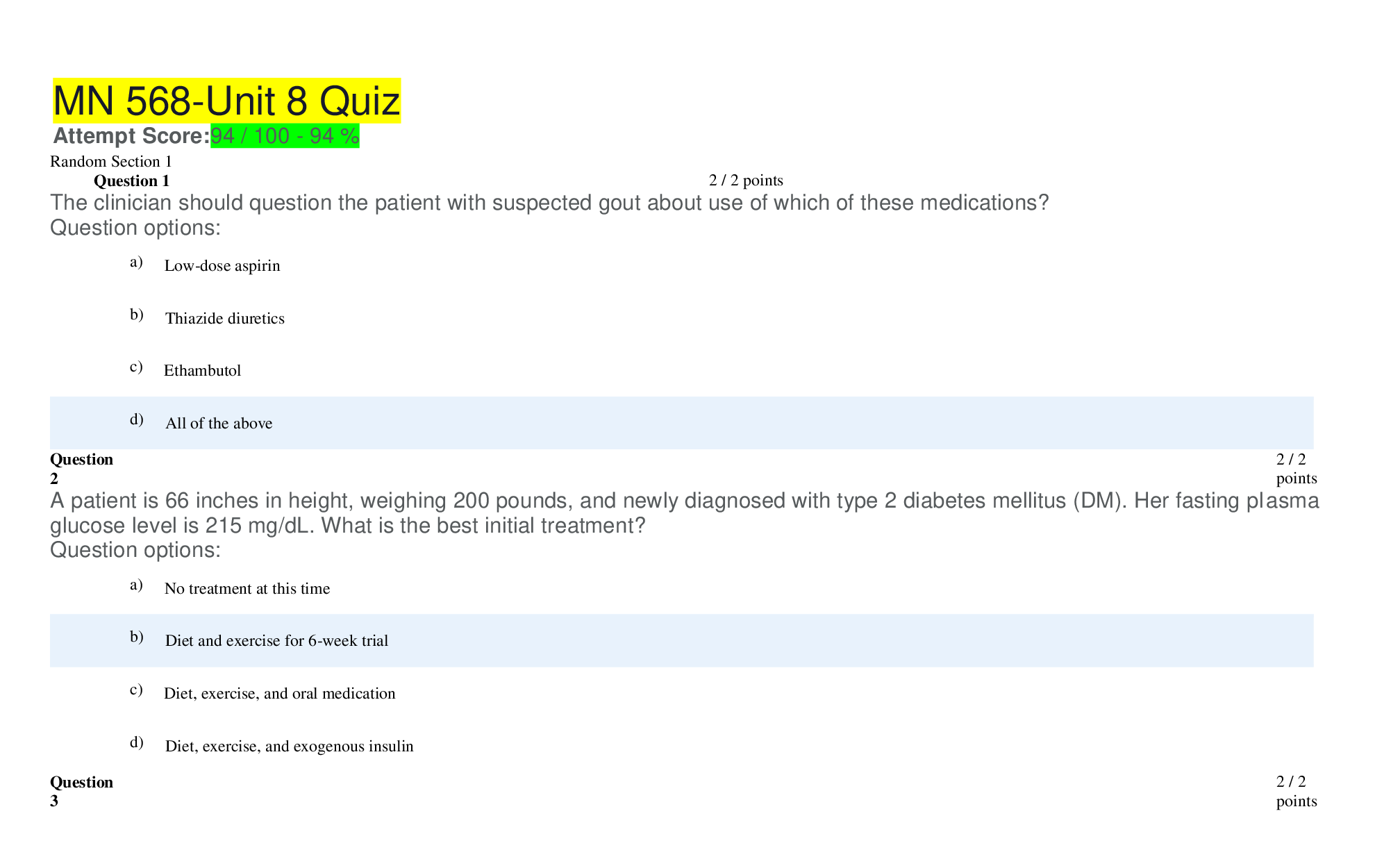
Reviews( 0 )
Recommended For You
Management> EXAM > Kaplan University, Indiana - MN 568/MN568-Unit 2 Question And Answers_100% Correct. (All)
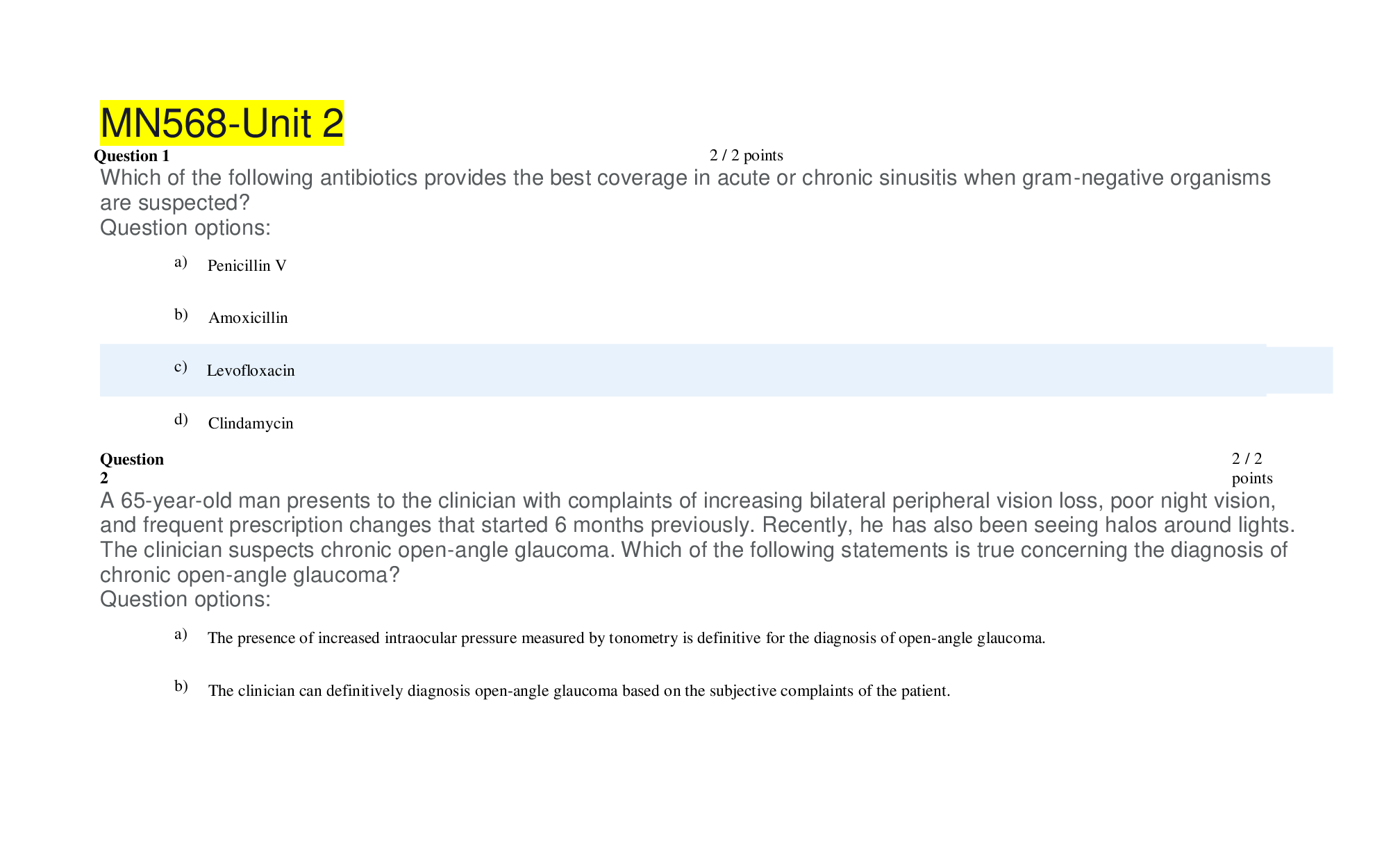
Kaplan University, Indiana - MN 568/MN568-Unit 2 Question And Answers_100% Correct.
MN568-Unit 2 Question 1 2 / 2 points Which of the following antibiotics provides the best coverage in acute or chronic sinusitis when gram-negative organisms are suspected? Question options: a...
By Succeed , Uploaded: Aug 05, 2020
$23.5
*NURSING> EXAM > NUR 2058 Dimensions Of Nursing Final Exam > Rasmussen College (2019/20) - Already Graded A (All)
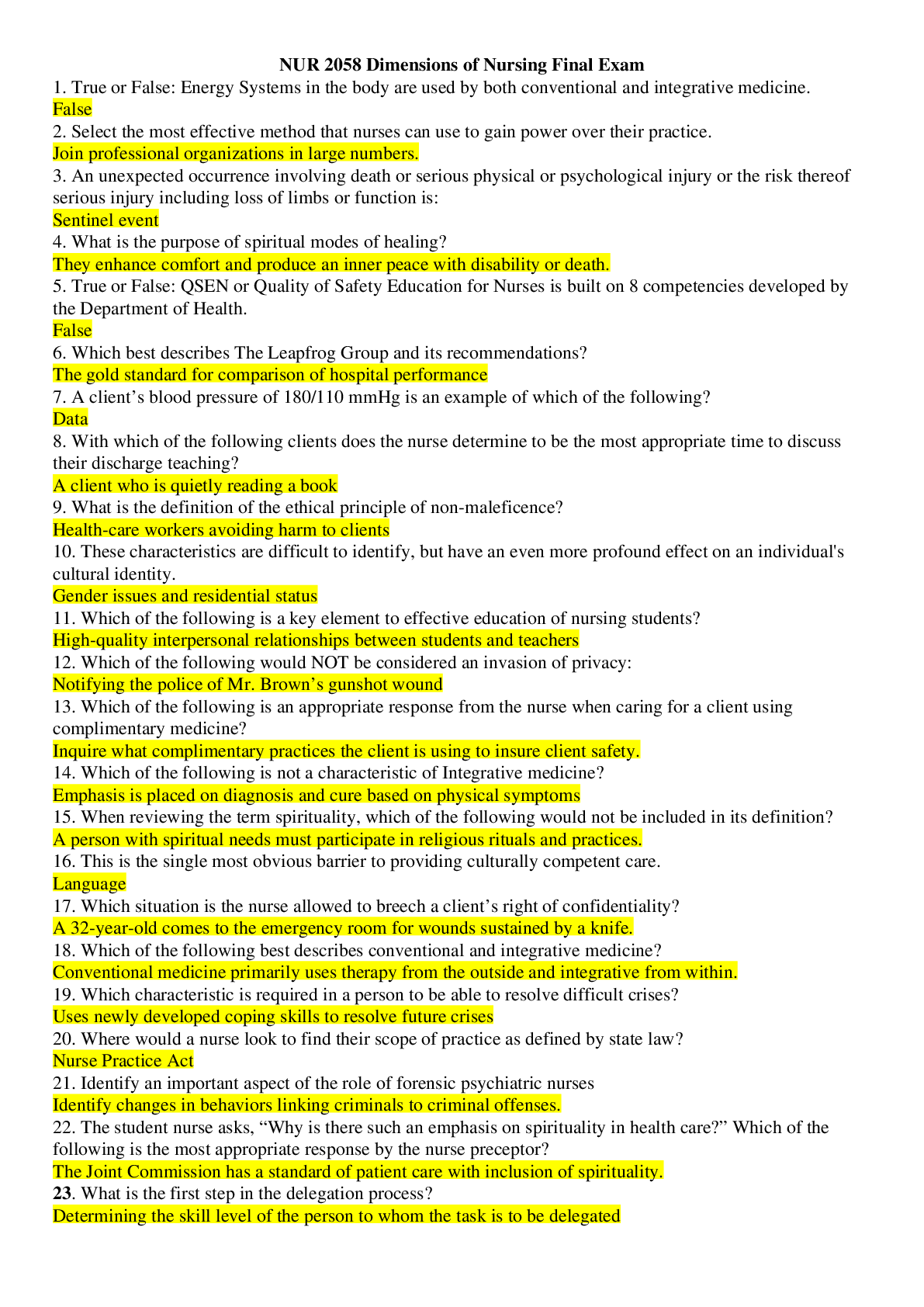
NUR 2058 Dimensions Of Nursing Final Exam > Rasmussen College (2019/20) - Already Graded A
NUR 2058 Dimensions of Nursing Final Exam 1. True or False: Energy Systems in the body are used by both conventional and integrative medicine. 2. Select the most effective method that nurses can us...
By Expert1 , Uploaded: Oct 21, 2019
$9
*NURSING> EXAM > Chapter 39: Hyperlipidemia > NSG 6005; St. Petersburg College (2019/20) - Already Graded A (All)
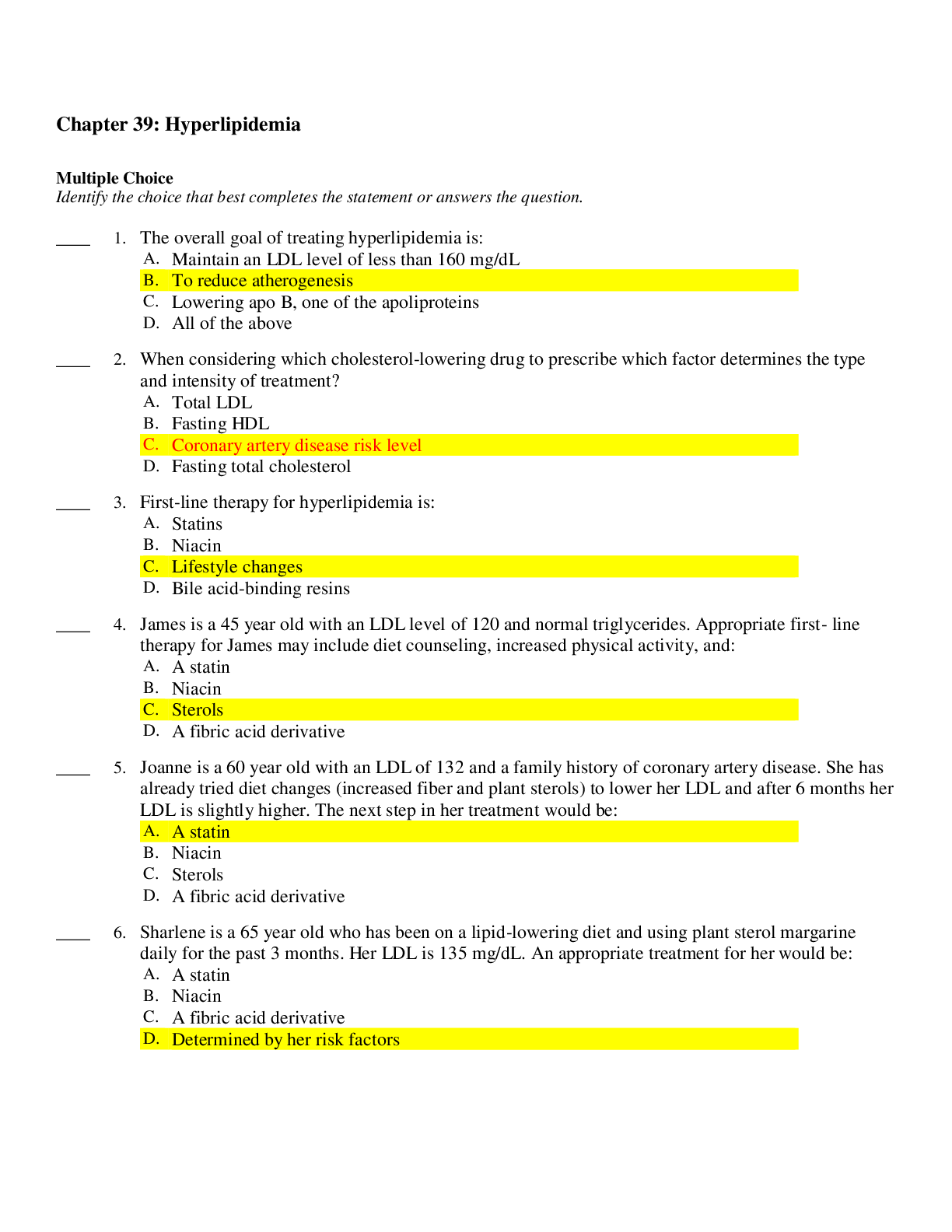
Chapter 39: Hyperlipidemia > NSG 6005; St. Petersburg College (2019/20) - Already Graded A
Chapter 39: Hyperlipidemia Multiple Choice Identify the choice that best completes the statement or answers the question. ____ 1. The overall goal of treating hyperlipidemia is: A. Maintain an...
By Expert#1 , Uploaded: Oct 12, 2019
$3
Applied Science> EXAM > RBT Training Flashcards - RBT Training Modules | 281 Questions and Answers 100% Correct | COMPLETE | 42 Pages (All)
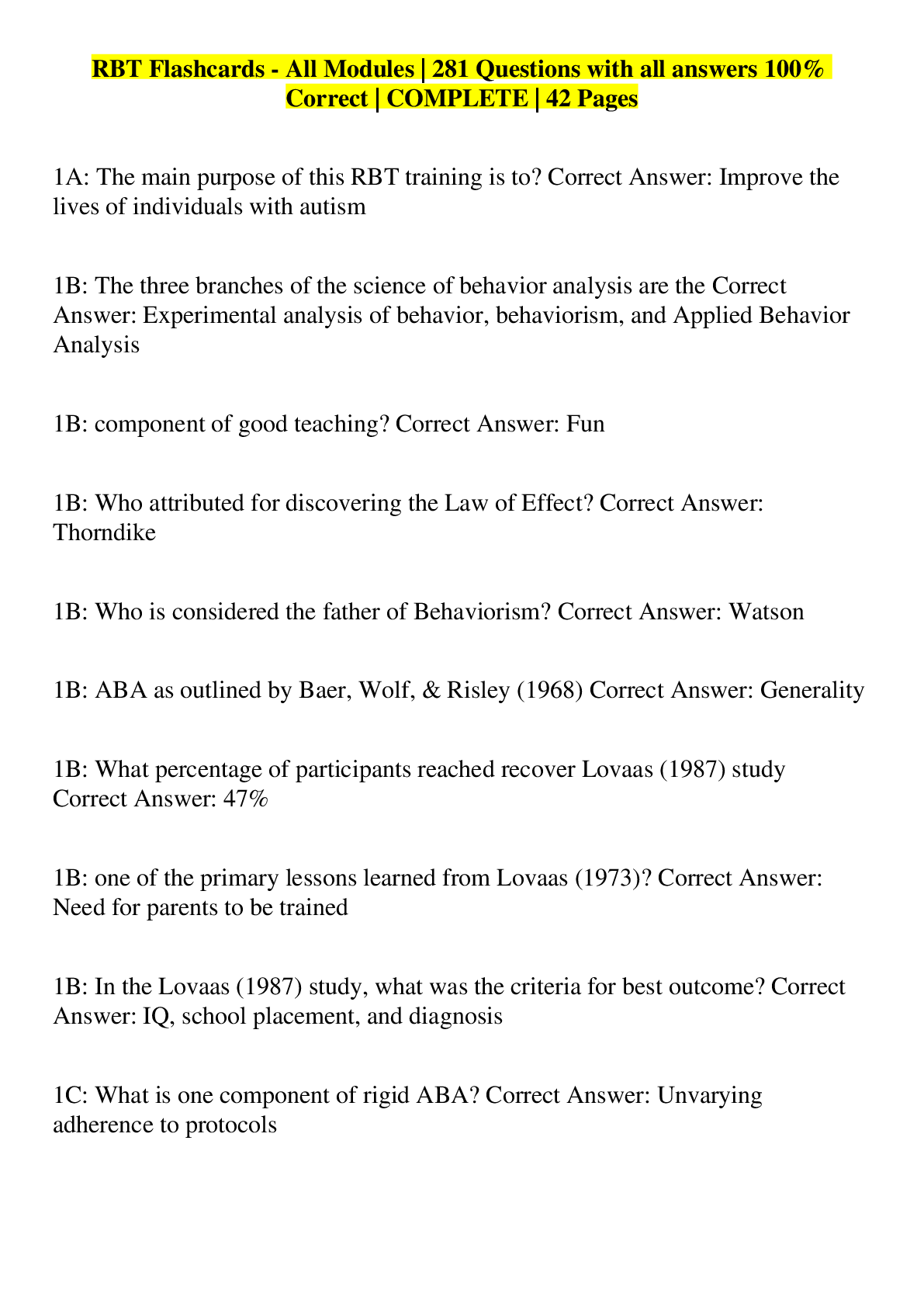
RBT Training Flashcards - RBT Training Modules | 281 Questions and Answers 100% Correct | COMPLETE | 42 Pages
1A: The main purpose of this RBT training is to? - ✔✔Improve the lives of individuals with autism 1B: The three branches of the science of behavior analysis are the - ✔✔Experimental analysis of beh...
By Tessa , Uploaded: Aug 08, 2022
$12
*NURSING> EXAM > Metaplastic cells are not better prepared to survive under stressful circumstances - Hypertrophy can occur under normal and pathological conditions- Cell proliferation is the process in which proliferating cells become more specialized cell types..Final Exam- Requires Respondus LockDown (All)

Metaplastic cells are not better prepared to survive under stressful circumstances - Hypertrophy can occur under normal and pathological conditions- Cell proliferation is the process in which proliferating cells become more specialized cell types..Final Exam- Requires Respondus LockDown
Question 1 2.5 / 2.5 pts True/False: Metaplastic cells are not better prepared to survive under stressful circumstances. True Correct! False Question 2 2.5 / 2.5 pts True/False:...
By Allan100 , Uploaded: Aug 04, 2022
$10
History> EXAM > SAE 3701 Exam -Before formal schools, indigenous education in precolonial societies was intertwined with -Education in precolonial communities involved (CONTAINS OVER 300 Q&A) (All)
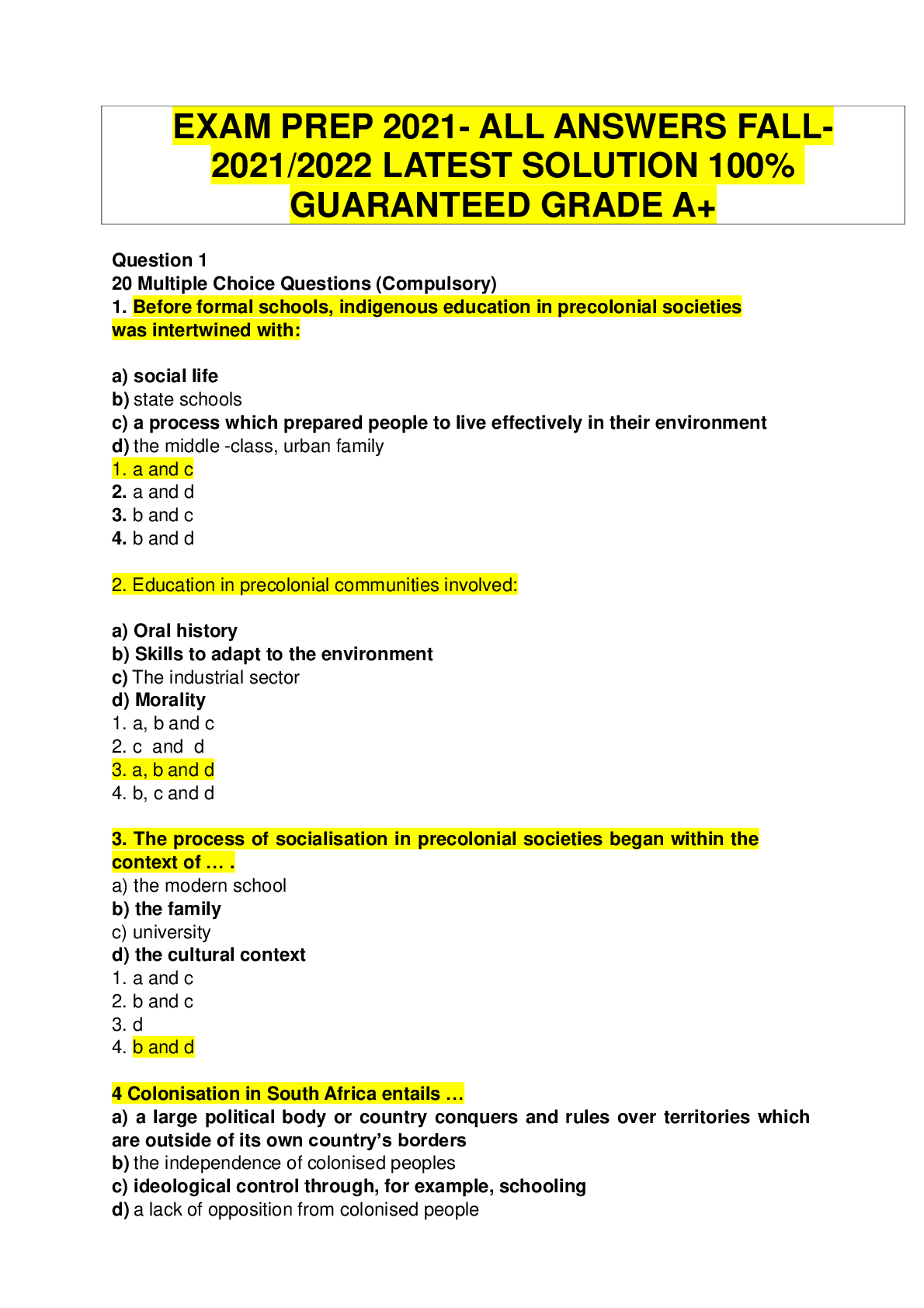
SAE 3701 Exam -Before formal schools, indigenous education in precolonial societies was intertwined with -Education in precolonial communities involved (CONTAINS OVER 300 Q&A)
Question 1 20 Multiple Choice Questions (Compulsory) 1. Before formal schools, indigenous education in precolonial societies was intertwined with: a) social life b) state schools c) a process wh...
By Allan100 , Uploaded: Aug 04, 2022
$8
*NURSING> EXAM > NUR2488 - NUR 2488 Mental Health Nursing Final Exam - Rasmussen (All)
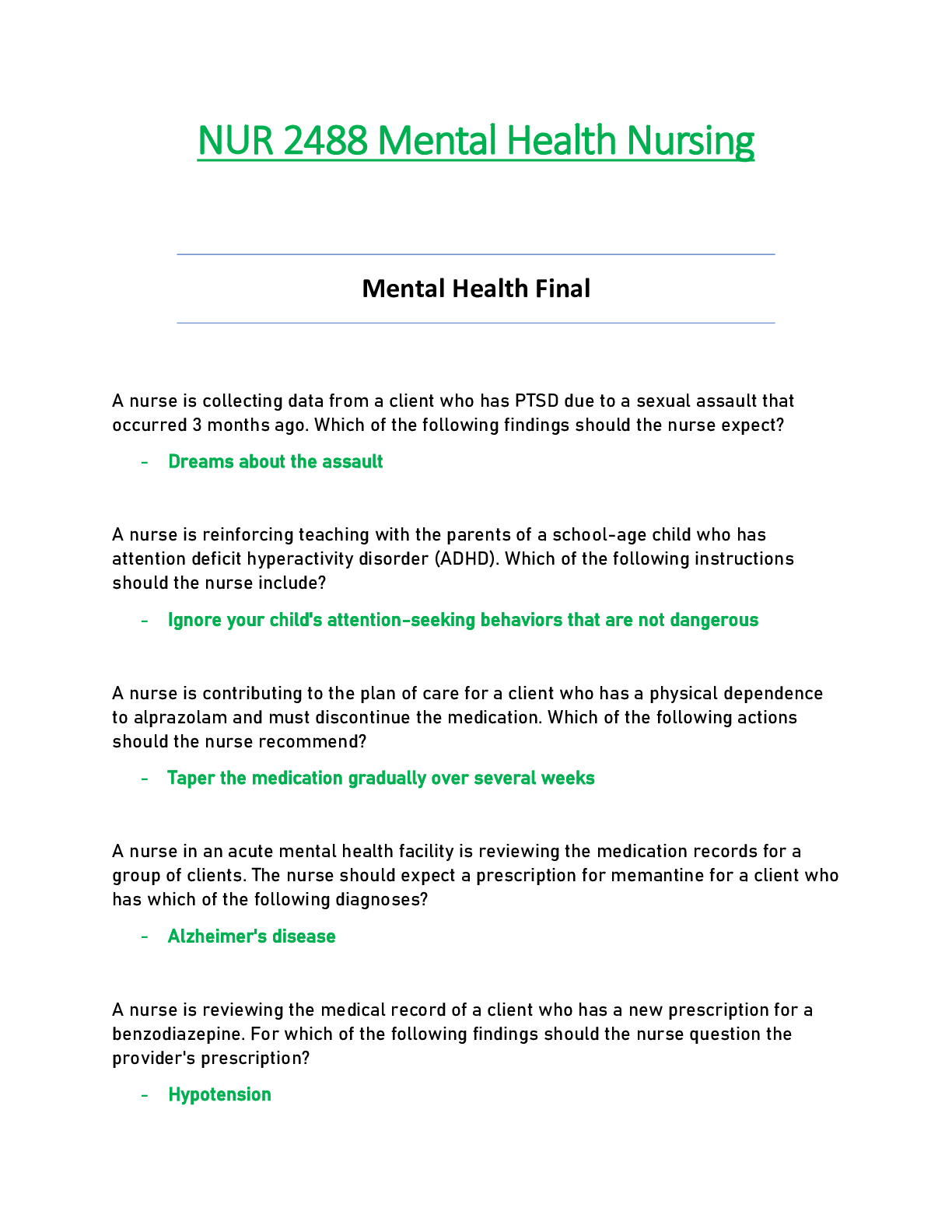
NUR2488 - NUR 2488 Mental Health Nursing Final Exam - Rasmussen
Mental Health Final NUR 2488 Mental Health Nursing Mental Health Final A nurse is collecting data from a client who has PTSD due to a sexual assault that occurred 3 months ago. Which of the...
By quiz_bit , Uploaded: May 30, 2021
$10
Mathematics> EXAM > Math 225n Statistics Quiz Week 6 (All)
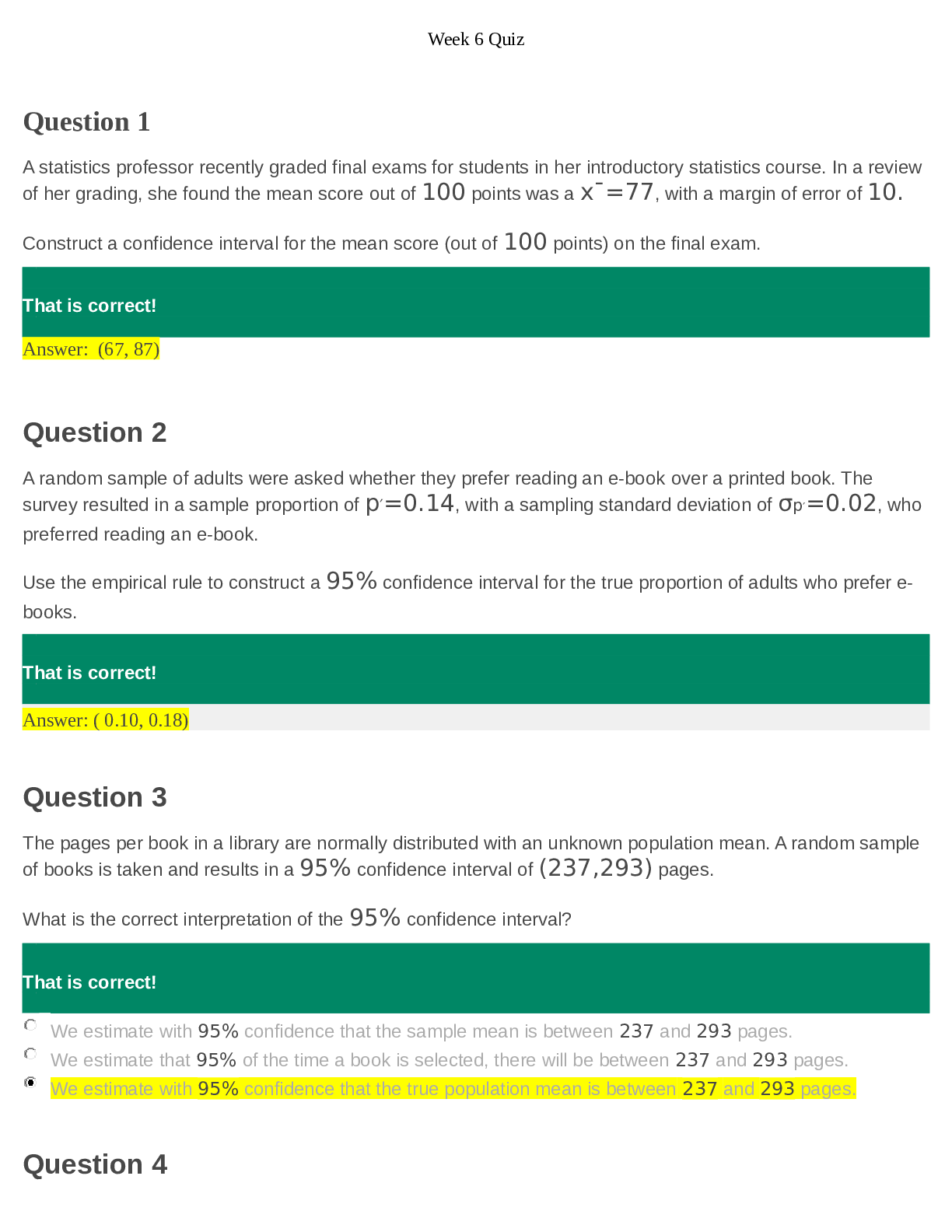
Math 225n Statistics Quiz Week 6
Question 1 A statistics professor recently graded final exams for students in her introductory statistics course. In a review of her grading, she found the mean score out of 100 points was a x¯=77, w...
By Dr Fiona , Uploaded: Jun 14, 2021
$11
*NURSING> EXAM > NUR2790 - NUR 2790 Final Exam Professional Nursing III / PN3 - Q & A Updated,Rasmussen (All)
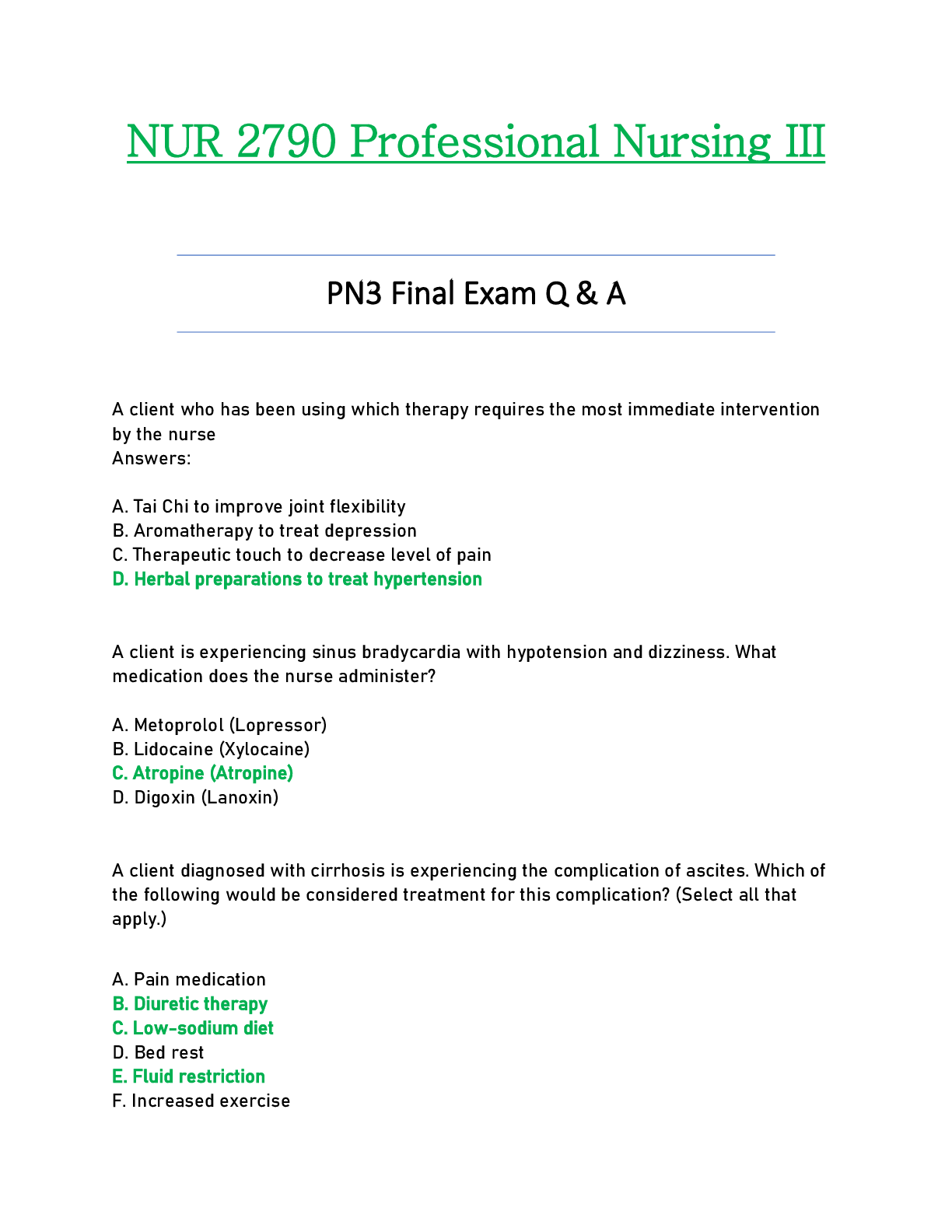
NUR2790 - NUR 2790 Final Exam Professional Nursing III / PN3 - Q & A Updated,Rasmussen
NUR 2790 Professional Nursing III / PN3 Final Exam Q & A NUR 2790 Professional Nursing III PN3 Final Exam Q & A A client who has been using which therapy requires the most immediate interve...
By quiz_bit , Uploaded: May 29, 2021
$10
Statistics> EXAM > MATH 225N Week 6 Statistics Quiz - Chamberlain College of Nursing. (All)
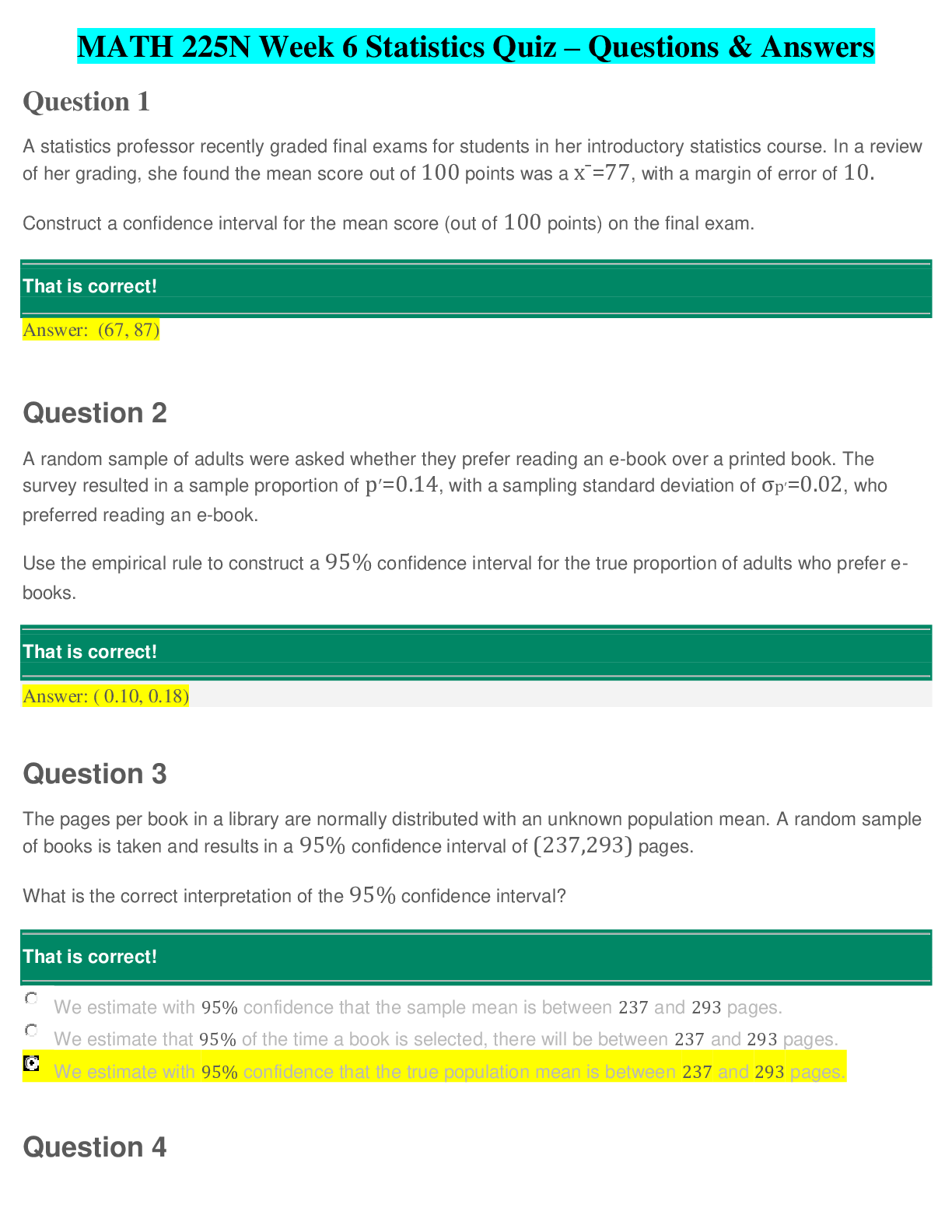
MATH 225N Week 6 Statistics Quiz - Chamberlain College of Nursing.
MATH 225N Week 6 Statistics Quiz (Questions & Answers) 1. Question: A statistics professor recently graded final exams for students in her introductory statistics course. In a review of her grading...
By Expert1 , Uploaded: Apr 26, 2020
$11
Document information
Connected school, study & course
About the document
Uploaded On
Oct 24, 2019
Number of pages
20
Written in
Additional information
This document has been written for:
Uploaded
Oct 24, 2019
Downloads
0
Views
77






